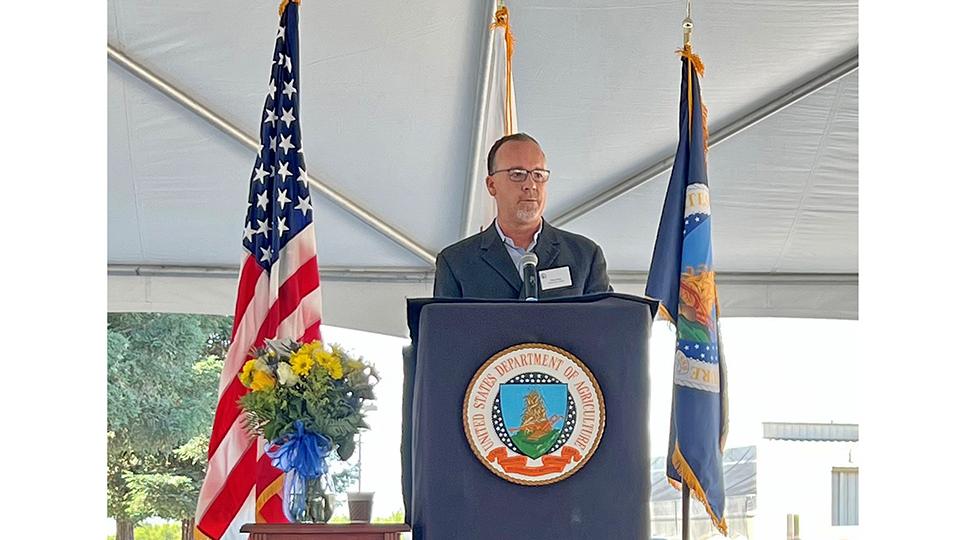A Century Of Grape Breeding And Still Growing Strong

Ross Jones addresses the California table grape growing community at the San Joaquin Valley Agricultural Sciences Center in Parlier. The ceremony was held recently to celebrate 100 years of cooperative research in grape breeding.
Photo courtesy of California Table Grape Commission
California table and raisin grape growers joined with all those connected with the program that produced such groundbreaking varieties as the ‘Crimson Seedless’ table grape and ‘Selma Pete’ raisin in a September ceremony at the San Joaquin Valley Agricultural Sciences Center in Parlier.
Celebrating 100 years of scientific development that resulted in the creation of many new table and raisin grape varieties, growers joined California Table Grape Commission officials and local, regional, and national USDA ARS officials to commemorate the anniversary and decades of successful partnership.
“The California table grape-growing community has partnered with ARS since 1981 to develop new varieties and since 2001 to protect and commercialize them in the U.S. and grape-growing countries around the world,” Ross Jones, the commission’s Senior Vice President and Chief Science and Technology Officer, told the audience. He recognized the accomplishments of breeders Dr. David Ramming, Dr. Craig Ledbetter, and members of their teams.
“They have worked to bring the hopes and dreams of generations of growers to fruition through the development of the kind of new cultivars that changed the trajectory of individual farming operations and the expectations and eating habits of consumers around the world,” Jones said. “It is not an overstatement to say this program changed the table grape industry and the world of table grape breeding. The new varieties that have emerged have, without question, helped the table grape farming community be sustainable and competitive.”
PUBLIC VS. PRIVATE
Though private breeders have developed numerous varieties in recent years, USDA-bred table grape varieties accounted for 36% of the volume California table grape growers produced in 2022. Jones said the celebration commemorating the past represents the launch point for the next level partnership planned between ARS and the table grape growing community through the commission.
One breeder who visited the program many times over the years, John Clark, Distinguished Professor of Horticulture from the University of Arkansas, says Ramming’s accomplishments should not be underestimated, as the USDA table and raisin grape breeding program was a world-changing effort and had a tremendous impact on California and world industries.
“Longtime breeder David Ramming is one of our fruit-breeding geniuses, and with skills and tremendous effort, he had impact that most fruit breeders can only dream of,” Clark says. “And he was an unbelievably disciplined hard worker, with endless hours in that hot San Joaquin Valley evaluating grapes. It has been an honor to know David Ramming.”
Clark, who writes a column for American Fruit Grower, says Ramming helped make the move to private breeding possible.
“It is important for us to keep in mind the value of public fruit-breeding efforts, and the USDA grape-breeding program, similar to the early impact of the USDA blueberry- breeding effort, which made these crops what they are today,” he says. “This is particularly important as we experience more and more of our private programs providing variety improvements these days.”
ALL ABOUT TEAMWORK
Ramming says he was just part of a team: Richard Emershad, the scientist in charge of the lab who helped develop the grape embryo culture procedure; Satomi Hiyama, who managed the students; and Field Man extraordinaire Ronald Tarailo, “who could have run it by himself at the end of the program. It wasn’t just me. I had a great crew, and without them, we couldn’t have achieved what we do.”
The roster of varieties the team developed is impressive. Table grapes include the aforementioned ‘Crimson Seedless’, ‘Scarlet Royal’, ‘Autumn King’, and ‘Autumn Royal’. Besides ‘Selma Pete’, there was ‘DOVine’, the first variety introduced from embryo culture, allowing for a seedless v. seedless cross, Ramming says. It wouldn’t have been possible to develop the grape embryo rescue technique without the financial support of the California Raisin Advisory Board.
One other significant raisin Ramming and his team developed was ‘Sunpreme’, which requires no cutting of the cane to make the fruit dry. It is also spur-fruitful, he says, which allows for mechanical pruning and harvest.
Ramming says his greatest achievement was not so much the great varieties but how they affected the growers themselves. He will never forget hearing from growers at his retirement party who told him they really appreciated the development of large-sized varieties such as ‘Autumn King’ because it saved them from spraying so much gibberellic acid to get the fruit up to a size that commands premium prices. Ramming recalls one particular grower who said he used to spray at all hours of the day, even getting up in the middle of the night to spray because he had to get the size up.
“So, he said that now he gets to spend more time with his family,” Ramming says, adding that that in itself was enough achievement for him: “Growers could spend more time with their families.”









